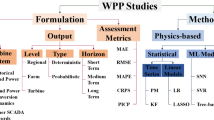Abstract
The energy consumption of an enterprise energy management system (EMS) is a complex process with nonlinearity, time-variance, larger delay, greater inertia and other dynamic characteristics, resulting in the failure of a single-item prediction model to achieve satisfactory prediction results. In this paper, a combination prediction method, based on BP neural network, was proposed to predict the energy consumption of an enterprise EMS for improving the prediction accuracy. The energy consumption of enterprise energy management system (EMS) was predicted and analyzed using gray combination models, i.e., GM (1.1) and pGM (1.1), gray Markov chain, and BP neural network prediction model. These single-item models and their prediction processes were constructed and successfully applied to predict the energy consumption of iron and steel enterprises. The data pertaining to energy consumption of these enterprises from January to December 2018 and January to March 2019 were used for predicting the simulation and testing, respectively. The results showed that the prediction results of our approach has an average relative error of 3.327% and 1.298% respectively, which are extremely lower than the existing approaches for improving the prediction accuracy.




Similar content being viewed by others
References
Gao J (2020) Performance evaluation of manufacturing collaborative logistics based on BP neural network and rough set[J]. Neural Comput & Applic 12V(2) pp.1–16
Pei J, Liu W (2019) Evaluation of Chinese Enterprise safety production resilience based on a combined gray relevancy and BP neural network model. Sustain 11(16):4321
Wang H, Zhang Q (2019) Dynamic identification of coal-rock interface based on adaptive weight optimization and multi-sensor information fusion. Inf Fusion 51:114–128
Qi G, Wang H, Haner M, Weng C, Chen S, Zhu Z (2019) Convolutional neural network based detection and judgement of environmental obstacle in vehicle operation. CAAI Trans Internet Technol 4(2):80–91
Xu X, Zhao Z, Xu X, Yang J, Chang L, Yan X, Wang G (2020) Machine learning-based wear fault diagnosis for marine diesel engine by fusing multiple data-driven models. Knowl-Based Syst 190:105324
Alguliyev RM, Aliguliyev RM, Sukhostat LV (2020) Efficient algorithm for big data clustering on single machine. CAAI Trans Internet Technol 5(1):9–14
Reynolds J, Rezgui Y, Kwan A, Piriou S (2018) A zone-level, building energy optimisation combining an artificial neural network, a genetic algorithm, and model predictive control. Energy 151:729–739
Li M, Patiño-Echeverri D, Zhang JJ (2019) Policies to promote energy efficiency and air emissions reductions in China's electric power generation sector during the 11th and 12th five-year plan periods: achievements, remaining challenges, and opportunities. Energy Policy 125:429–444
Mostafa SM (2019) Imputing missing values using cumulative linear regression. CAAI Trans Internet Technol 4(3):182–200
Xin W, Lu Z, Danli W, Xiaoying X (2000) MATLAB neural network application design [M]. Sci Technol Press 3(5):21–47
Shokri M, Tavakoli K (2019) A review on the artificial neural network approach to analysis and prediction of seismic damage in infrastructure. Int J Hydromechatronics 2(4):178–196
Tan ZX, Thambiratnam DP, Chan THT, Razak HA (2017) Detecting damage in steel beams using modal strain energy based damage index and artificial neural network. Eng Fail Anal 79:253–262
Du M, Luo J, Wang S, Liu S (2020) Genetic algorithm combined with BP neural network in hospital drug inventory management system. Neural Comput & Applic 32(7):1981–1994
Nariman NA, Mohammad II, Karampour P (2019) Investigation of staggered block shear failure in a steel tension member utilising minimax optimisation. Int J Hydromechatronics 2(4):133–143
Tounsi A (2019) Optimisation analysis of nanocomposite pipes with internal fluid flow under external excitation. Int J Hydromechatronics 2(1):1–15
Wang T, Sui S, Tong S (2017) Data-based adaptive neural network optimal output feedback control for nonlinear systems with actuator saturation. Neurocomputing 247:192–201
Author information
Authors and Affiliations
Corresponding author
Additional information
Publisher’s note
Springer Nature remains neutral with regard to jurisdictional claims in published maps and institutional affiliations.
Rights and permissions
About this article
Cite this article
Xu, S., Alturki, R., Rehman, A.U. et al. BP Neural Network Combination Prediction for Big Data Enterprise Energy Management System. Mobile Netw Appl 26, 184–190 (2021). https://doi.org/10.1007/s11036-020-01698-x
Accepted:
Published:
Issue Date:
DOI: https://doi.org/10.1007/s11036-020-01698-x




